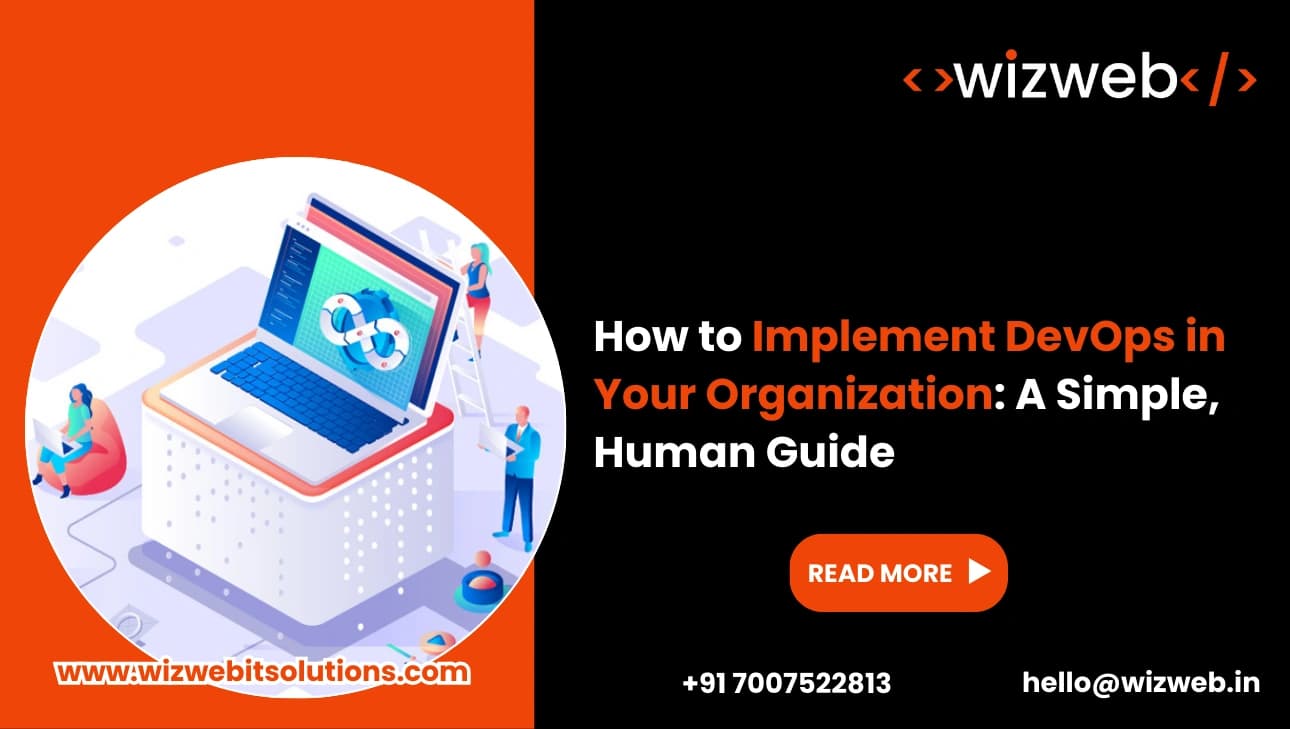Get in Touch
- Phone
+91 700 752 2813
- Email Now
hello@wizweb.in
Office No - 204 A-140, Sector 63 Road Noida, Uttar Pradesh 201301

If your team ships code slowly, fixes the same bugs again and again, or worries every time there is a release, it’s a strong sign you should Implement DevOps. DevOps is not just a set of tools. It is a way of working that helps your developers, testers, security teams, and operations people act like one team. The result is faster delivery, fewer surprises, and happier users. In this guide, I’ll explain how to Implement DevOps step by step, in clear and simple language, with examples you can follow right away.
Before you buy a single tool, talk about how people work together. To Implement DevOps, start with trust and shared responsibility. It should never be “dev vs ops.” Instead, the team owns the product together—from the first line of code to the moment it runs in production.
Simple actions you can try this week:
These habits create safety, and safety makes change possible. This is how you Implement DevOps without fear.
When you Implement DevOps, you need a clear way to say, “Yes, this is working.” Four simple metrics are enough to start:
You don’t need perfect numbers. Even rough data is fine. Put the numbers on a small dashboard and review them weekly. When you Implement DevOps with shared metrics, people focus on results instead of opinions.
Take a whiteboard and draw your current process from idea to production. Where does work wait? Where does it bounce between teams? Do tests take too long? Are approvals slow? Pick the one biggest delay and fix that first. For example:
By removing a single blocker, you’ll feel the first real win of Implement DevOps.
Continuous Integration (CI) and Continuous Delivery (CD) are the backbone of DevOps. To Implement DevOps in a safe way, begin with one service or app, not your entire platform.
A tiny first pipeline can look like this:
Once this is stable, add more steps: integration tests, security scans, and automated deployment to production. Keep it simple. The goal is a reliable, repeatable path from code to customers.
Bugs and security issues are cheaper to fix early. When you Implement DevOps, move checks into the pipeline:
Later, you can add more: static code analysis, container scanning, and “policy as code.” This gives you speed without losing safety.
If code is the brain, observability is the eyes and ears. You need logs, metrics, and tracing so you can see how the system behaves in real life. When you Implement DevOps with strong observability, you can find issues before customers report them and fix incidents faster. Start with:
The goal is calm operations, even during busy times.
At first, one team can handle everything. As you Implement DevOps across more apps, create a small “platform” or “enablement” team. Their job is to build golden templates, shared tools, and best practices that other teams can use. Product teams keep full ownership of their services, while the platform team makes the happy path smooth and safe. This structure reduces friction and keeps standards consistent without heavy rules.
Some changes are low risk; others are not. Treat them differently. For low-risk changes, automate approvals through your pipeline. For higher-risk changes, keep human review and clear checklists. This lets you Implement DevOps without fighting your audit or compliance needs. Over time, you’ll find that most changes become low risk because your tests and rollbacks are strong.
Here is a simple roadmap you can copy:
Days 1–30: Foundations
Days 31–60: Automate and observe
Days 61–90: Harden and scale
This plan helps you Implement DevOps calmly, with steady progress and visible results.
You do not need a huge toolchain to begin. Choose tools that solve today’s bottleneck and can grow with you. Some companies also bring in DevOps Services to speed up the first setup, audit current workflows, or coach teams. If you consider DevOps Services, ask for:
Good partners help you Implement DevOps in a way that your team can own, not depend on forever.
To Implement DevOps, think people first, then process, then tools. Pick one service, build a small but strong pipeline, measure the right things, and learn after every change. Add security early, make the system observable, and keep improving in small steps. Whether you build everything in-house or get a boost from DevOps Services, these practical steps will help you Implement DevOps with confidence.